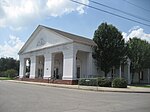Naval Air Station Joint Reserve Base New Orleans

Naval Air Station Joint Reserve Base New Orleans is a base of the United States military located in Belle Chasse, unincorporated Plaquemines Parish, Louisiana, United States. NAS JRB New Orleans is home to a Navy Reserve aggressor squadron and a fleet logistics support squadron, the 159th Fighter Wing (159 FW) of the Louisiana Air National Guard, Coast Guard Air Station New Orleans, a detachment of a Marine Corps Reserve light helicopter attack squadron, as well as other US Navy and US Army activities. The base has a 24/7 operating schedule to support both the 159 FW's NORAD air sovereignty/homeland defense requirements and for Coast Guard Air Station New Orleans search and rescue/maritime law enforcement/port security missions. It contains a military airport known as Alvin Callender Field (IATA: NBG, ICAO: KNBG, FAA LID: NBG) which is located three nautical miles (6 km) south of the central business district of New Orleans. The base's predecessor, NAS New Orleans, occupied the current location of the University of New Orleans's principal campus until 1957.
Excerpt from the Wikipedia article Naval Air Station Joint Reserve Base New Orleans (License: CC BY-SA 3.0, Authors, Images).Naval Air Station Joint Reserve Base New Orleans
Radm Fowler Drive,
Geographical coordinates (GPS) Address Nearby Places Show on map
Geographical coordinates (GPS)
| Latitude | Longitude |
|---|---|
| N 29.825277777778 ° | E -90.035 ° |
Address
Radm Fowler Drive
70037
Louisiana, United States
Open on Google Maps






